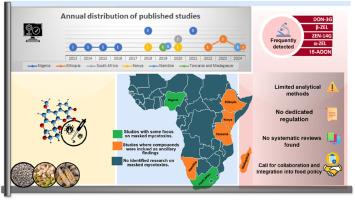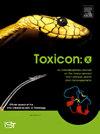撒哈拉以南非洲隐匿霉菌毒素研究的知识结构和演变:系统回顾和网络分析方法
IF 2.8
Q2 TOXICOLOGY
引用次数: 0
摘要
隐匿真菌毒素是无法进行常规检测的改性真菌毒素,对食品安全构成未被充分发掘的风险。尽管存在潜在的公共卫生风险,但对这些化合物的研究在撒哈拉以南非洲(SSA)仍然有限。本研究系统地回顾了22篇出版物,分析了研究趋势、地理焦点和知识差距,使用网络分析来评估SSA隐匿霉菌毒素研究的演变和结构。研究开始于2013年,从2014年到2017年每年一项研究缓慢增长,2018年到2024年每年适度增加到2-4项研究。从地理上看,研究工作集中在少数几个国家,特别是尼日利亚(占出版物的47.6%),埃塞俄比亚、南非、肯尼亚和纳米比亚也有零星贡献。研究结果显示,只有13.6%的研究将掩盖、修饰、新出现或隐藏真菌毒素作为研究目标的主要焦点的一部分,而大多数研究将其作为辅助发现。已查明的最普遍的隐匿真菌毒素是黄曲霉毒素和伏马菌素的衍生物,它们对食品安全和公共卫生构成重大风险。新出现的挑战包括有限的检测能力和对隐蔽性真菌毒素薄弱的监管框架,许多研究未能充分了解其影响。值得注意的是,没有发现专门针对隐蔽真菌毒素的系统综述,这表明存在重大的研究空白。该领域仍然是支离破碎和不发达的,在分析能力和地理范围方面有很大的限制。解决这些差距需要加强区域合作,增加对有针对性研究的资助,并将隐匿霉菌毒素监测纳入国家食品安全政策。本文章由计算机程序翻译,如有差异,请以英文原文为准。

Knowledge structure and evolution of masked mycotoxin research in Sub-Saharan Africa: A systematic review and network analysis approach
Masked mycotoxins are modified forms of mycotoxins that escape conventional detection, posing underexplored risks to food safety. Despite their potential public health risks, research on these compounds remains limited in Sub-Saharan Africa (SSA). This study systematically reviewed 22 publications, analyzing research trends, geographic focus, and knowledge gaps using network analysis to assess the evolution and structure of masked mycotoxin research in SSA. Studies began in 2013, grew slowly with one study per year from 2014 to 2017, and modestly increased to 2–4 studies annually between 2018 and 2024. Geographically, research efforts are concentrated in a few countries, particularly Nigeria (47.6 % of publications), with Ethiopia, South Africa, Kenya, and Namibia contributing sporadically. The findings reveal that only 13.6 % of the studies had masked, modified, emerging, or hidden mycotoxins as part of the primary focus of the study objectives, while the majority included them as ancillary findings. The most prevalent masked mycotoxins identified are derivatives of aflatoxins and fumonisins, which pose significant risks to food safety and public health. Emerging challenges include the limited detection capabilities and weak regulatory frameworks on masked mycotoxins, with many studies failing to capture the full extent of their impact. Notably, no systematic reviews were found to focus exclusively on masked mycotoxins, indicating a major research gap. The field remains fragmented and underdeveloped, with significant limitations in analytical capacity and geographic scope. Addressing these gaps requires enhanced regional collaboration, increased funding for targeted research, and the integration of masked mycotoxin monitoring into national food safety policies.
求助全文
通过发布文献求助,成功后即可免费获取论文全文。
去求助
来源期刊

Toxicon: X
Pharmacology, Toxicology and Pharmaceutics-Toxicology
CiteScore
6.50
自引率
0.00%
发文量
33
审稿时长
14 weeks
 求助内容:
求助内容: 应助结果提醒方式:
应助结果提醒方式:


